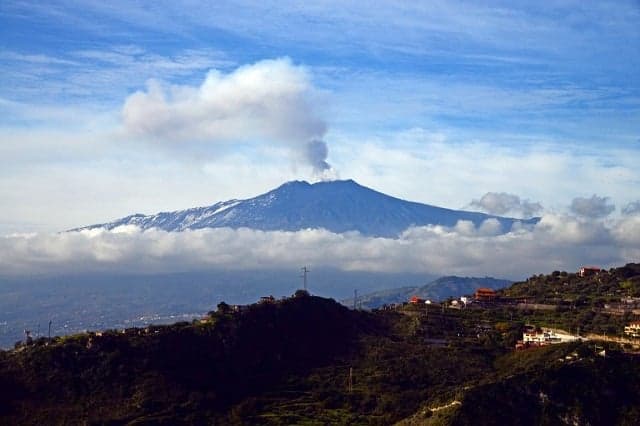IN PHOTOS: Eruptions continue at Etna after explosion that injured ten

After a violent explosion on Thursday left ten people injured, the volcanic activity at Sicily's Mount Etna has continued.
The regional Civil Protection Agency has banned access to the volcano above 2,600 metres - even if accompanied by guides - while the local Catania airport limited hourly landings to five per hour. However, the lava flow is directed far from population centres and is not thought to pose a risk to local residents.
Thursday's explosion occurred at a height of 2,700 metres. It happened at 12.43pm (1143 GMT) when the steam trapped between the lava and the surface of the mountain escaped in a powerful burst, Stefano Branca, of the Italian institute of geology and volcanology (INGV), told AFP.
The lava flows reached temperatures of 1,000C, according to volcanologists.
There were around 35 people in the area close to the explosion, including a BBC team, 15 tourists, scientists and guides, said Nino Borzi, mayor of Nicolosi, the closest residential area. "There were ten injuries but none serious," he said.
"Very relieved to be safe" - the terrifying moment @BBCMorelle and crew were caught up in Mount Etna eruption https://t.co/11inHwxYPO pic.twitter.com/Zz0JKmWU1v
— BBC News (World) (@BBCWorld) March 16, 2017
#etna #etnalive #vulcano #sicilia #volcano #sicily https://t.co/nw4qiNnIlf pic.twitter.com/dR7HA6s6Bk
— EtnaLive (@EtnaLive) March 17, 2017
The volcano, which is Europe's highest and most active, began erupting early on Wednesday, though by Thursday morning volcanologists had said the eruptive phase was "diminishing".
But after the blast on Thursday morning, eruptions described as being of "moderate intensity" continued through the evening and night, with lava and ash thrown into the air, and captured in spectacular images.
#etna #etnalive spettacolo notturno Domenico Mazzaglia #eruzione #eruption #lava #volcano #vulcano #geology pic.twitter.com/aL7SaScF8R
— EtnaLive (@EtnaLive) March 16, 2017
Mount Etna
Etna, nestled between the cities of Messina and Catania, is in a near-constant state of activity, meaning its shape changes more frequently than any other volcano.
Its last eruptive episode lasted from February 27th to March 1st, with dramatic, vertical streams of lava continuing to erupt for several days.
Before that, experienced a flurry of activity in January, which saw some local schools briefly evacuated.
Together with Mount Vesuvius near Naples, Etna is one of 16 volcanoes in the world designated as 'Decade Volcanoes' by the UN, which means that they are studied particularly closely due to the frequency of activity and density of nearby population.
In 2013, the volcano was awarded Unesco World Heritage Status due to its "notoriety, scientific importance, and cultural and educational value".
Comments
See Also
The regional Civil Protection Agency has banned access to the volcano above 2,600 metres - even if accompanied by guides - while the local Catania airport limited hourly landings to five per hour. However, the lava flow is directed far from population centres and is not thought to pose a risk to local residents.
Thursday's explosion occurred at a height of 2,700 metres. It happened at 12.43pm (1143 GMT) when the steam trapped between the lava and the surface of the mountain escaped in a powerful burst, Stefano Branca, of the Italian institute of geology and volcanology (INGV), told AFP.
The lava flows reached temperatures of 1,000C, according to volcanologists.
There were around 35 people in the area close to the explosion, including a BBC team, 15 tourists, scientists and guides, said Nino Borzi, mayor of Nicolosi, the closest residential area. "There were ten injuries but none serious," he said.
"Very relieved to be safe" - the terrifying moment @BBCMorelle and crew were caught up in Mount Etna eruption https://t.co/11inHwxYPO pic.twitter.com/Zz0JKmWU1v
— BBC News (World) (@BBCWorld) March 16, 2017
#etna #etnalive #vulcano #sicilia #volcano #sicily https://t.co/nw4qiNnIlf pic.twitter.com/dR7HA6s6Bk
— EtnaLive (@EtnaLive) March 17, 2017
The volcano, which is Europe's highest and most active, began erupting early on Wednesday, though by Thursday morning volcanologists had said the eruptive phase was "diminishing".
But after the blast on Thursday morning, eruptions described as being of "moderate intensity" continued through the evening and night, with lava and ash thrown into the air, and captured in spectacular images.
#etna #etnalive spettacolo notturno Domenico Mazzaglia #eruzione #eruption #lava #volcano #vulcano #geology pic.twitter.com/aL7SaScF8R
— EtnaLive (@EtnaLive) March 16, 2017
Mount Etna
Etna, nestled between the cities of Messina and Catania, is in a near-constant state of activity, meaning its shape changes more frequently than any other volcano.
Its last eruptive episode lasted from February 27th to March 1st, with dramatic, vertical streams of lava continuing to erupt for several days.
Before that, experienced a flurry of activity in January, which saw some local schools briefly evacuated.
Together with Mount Vesuvius near Naples, Etna is one of 16 volcanoes in the world designated as 'Decade Volcanoes' by the UN, which means that they are studied particularly closely due to the frequency of activity and density of nearby population.
In 2013, the volcano was awarded Unesco World Heritage Status due to its "notoriety, scientific importance, and cultural and educational value".
Join the conversation in our comments section below. Share your own views and experience and if you have a question or suggestion for our journalists then email us at [email protected].
Please keep comments civil, constructive and on topic – and make sure to read our terms of use before getting involved.
Please log in here to leave a comment.